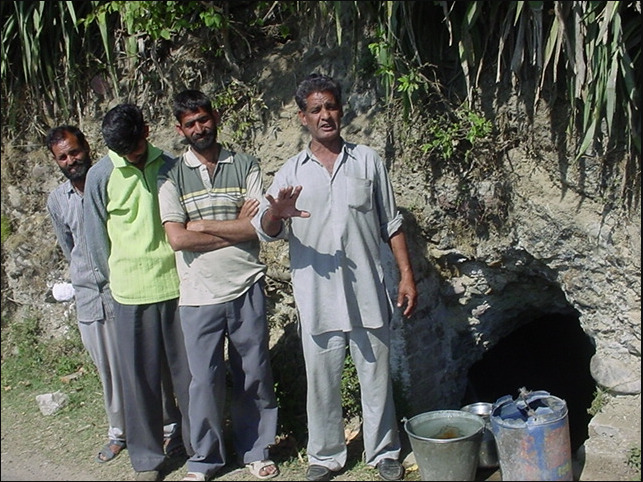Water scarcity is becoming a serious cause for human society to worry. Security experts are already thinking about ways to tackle the possibilities of water wars in the future. India is now amongst one of the countries with much less per capita availability of water. Several factors have contributed to water scarcity of water in our country in general and Himachal Pradesh in particular. Mismanagement of available resources, over exploitation, tendency of people and also the government to make money out of water, pollution of surface resources like rivers and encroachment of ponds and lakes are some of the factors that are making the situation grave.
The viable resource left now is groundwater. Pollution of ground water is becoming rampant and due to excessive drawl and less recharge the aquifers are becoming dry. As the days pass water is becoming scarce even in the areas where it was thought to be in plenty. It is important to turn the pages of history and learn what our ancestors and elders were doing in the past. For them despite being available in plenty, water was a revered commodity.
With the summer at its peak, several areas of Himachal Pradesh, especially Hamirpur, Kangra and Mandi districts have started facing the pinch of water shortage. This is despite the fact that Himachal Pradesh is known as hill State with high hills on its eastern side. Water from the melting of ice too becomes insufficient to quench thirst of the people due to scanty snowfall and also failure of the successive state governments to lift water available from the rivers flowing through the state for want of adequate funds.
However, in Hamirpur district and Sarkaghat subdivision of Mandi and the Changer areas of Kangra district people depend upon ‘khatri’ waters for daily needs.

‘Khatris’ are HAND HEWN CAVES. ‘Khatris’can be found on both sides of roads in the Bamsan area of the Hamirpur district, the area represented by senior BJP leader, Prof. Prem Kumar Dhumal in the parliament. It is surprising that this system of collecting water is in use in Hamirpur district since centuries ago.
Water from these sources is neat and clean, cool and fit for drinking, say local people. The medical officers working in the area dispute this claim of theirs. Shakti Chand Thakur of Khauda village told this reporter that the water of Khatris is fit for use and good for health. He ridiculed those who say that this water is unfit for human consumption. “When animals can live a long life with this water why not the human beings,” he asked from the critics.
Thakur has two such khatris in his house that is located on a hillock in Kahuda village of Mandi district located on the eastern side of Hamirpur district. He uses water of both for their daily need. He wants this culture to spread further as there is no substitute to it.
Since there are no permanent water sources in the area, people used to wait for the arrival of rains for water needs. ‘Khatris’ are constructed by digging rocks which are permanent sources of water. Once these ‘khatris’ are dug they are provided with iron gates and put under lock and key. Water seeps into the “khatris” from the rocks and is collected inside which is sufficient for daily use of human beings as well as animals.
Khatris are structures, about 10×12 feet in size and six feet deep carved out in the hard rock mountain. The specially trained masons construct them at a cost of Rs 10,000-20,000 each. These traditional water harvesting structures are found in Hamirpur, Kangra and Mandi districts of Himachal Pradesh.
There are two types of khatris: one for animals and washing purposes in which rain water is collected from the roof through pipes, for other are used for human consumption in which rainwater is collected by seepage through rocks. “As water is stored after filtration through different types of rocks, there is no question of impurity,” says Ram Singh of Sarahkar village.
Interestingly, the khatris are owned by individual as well as by a community. There are government khatris as well, which are maintained by the concerned gram panchayats. However, “their condition is not good. Both the government and the community are neglecting them “, according to local people.
Reports say that the people in Hamirpur, Kangra and Mandi districts have started cleaning ‘khatris’ and to chlorinate them to store safe water there with an eye on the drought like situation they are facing this season. Many others have also started digging ‘khatris’ as they feel that these may be beneficial for them in the coming days and it is useful to have more ‘khatris’ at disposal when the state government is also going to help them financially for the construction of new ones.
There was a time when people used not to marry their daughters in these areas fearing that their daughters will have to toil hard and their lives will be miserable. But now the situation has changed, thanks to the drinking water supply schemes framed by successive state governments since year 1977.
The state’s first such a big rural water supply scheme known as Lagwalti Bamsan drinking water supply scheme was launched with fanfare which has brought sea change in the lives of the people of respective villages. However, this scheme has now become insufficient for the people as most of the migrated people have returned to their villages and have constructed good houses to live in there.
The Himachal government has now drawn up a big plan for providing potable drinking water to the people of these areas at a cost of sixty eight crore rupees. A new water supply scheme named as 214 groups of villages of Bamsan and Mewa has been formulated by the present Congress government and it is hoped that this scheme will come into being by next summer. The government proposes to complete this scheme by October 31 this year.


